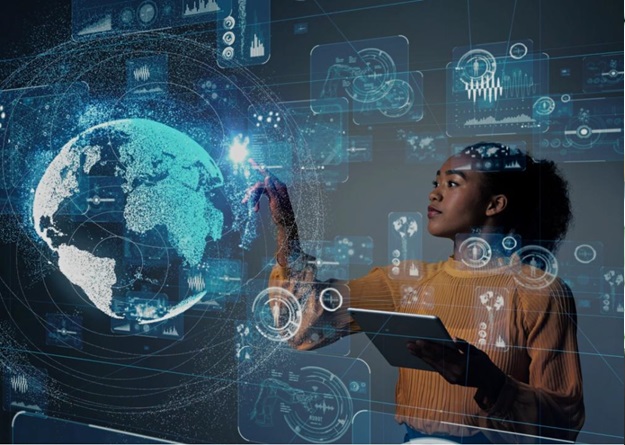You may not realize it, but transcription technology likely plays a role in your daily life. If you’ve ever watched a YouTube video with captions or used the speech-to-text function on your iPhone, you’ve been using transcription. Beyond these day-to-day uses, transcription is a valuable tool for business leaders, content creators and other professionals across a wide range of industries.
Transcription technology is constantly evolving, and professionals around the world continue to find new and innovative use cases for these tools. At its core, transcription offers an additional or alternative means of sharing information from audio or video files, and can help brands and individuals communicate more effectively with diverse audiences. In this how-to guide, we will explore the basics of converting audio to text and discuss the role transcription plays in various industries.
Introduction to transcription: understanding audio to text conversion
Generally speaking, transcription refers to the process of converting audio to text. A well-trained professional transcriber can capture live communications like conference calls and in-person lectures, as well as recordings.
Tools like voice-to-text and speech-to-text on modern smart devices are other forms of transcription. Artificial intelligence software powers these features by processing spoken text and converting it to text. To achieve this, the AI uses advanced language models. Some media-hosting and video-editing platforms use similar forms of technology to automatically transcribe audio and video content. Other platforms rely on the expertise of human transcriptionists for more accurate audio to text conversion.

Why transcribe audio to text?
There are several reasons why a business leader or content creator may choose to invest in transcription solutions. The importance of transcription as an accessibility tool has long been recognized by disability advocates and other professionals in the Diversity, Equity and Inclusion (DEI) space. Video and audio content is not always sufficiently accessible to individuals with certain disabilities and specific learning needs. Offering readable versions of the information can better support diverse audiences.
For example, transcription solutions offer support for:
- Those who are Deaf or hard of hearing
- Individuals with ADHD
- Community members with neurodivergent conditions like autism spectrum disorder
- People with auditory processing disorders
The benefits of transcription can also extend to community members of diverse backgrounds like individuals who are consuming content in a non-native language. Business leaders who choose to convert audio recordings to textual content may also notice a boost in efficiency and productivity within the workplace. Providing information in a written format is a great way to offer more equitable messaging for both on-site and remote workers. Transcripts can also serve as a valuable record-keeping tool because a text-based record is easier to reference and takes up less hard drive space than a lengthy audio or video recording. Sharing written transcripts online can also improve a business’s SEO ranking and drive additional traffic to an associated webpage.
Overview of the transcription process
There are a few different methods for transcribing audio depending upon the intended use or audience for a transcript. Generally speaking, however, the transcription process will look something like this:
- Step 1: A transcriptionist receives an audio recording or live audio feed.
- Step 2: The transcriber carefully listens to the audio.
- Step 3: The transcriber manually types out every audio element they hear. They may periodically need to pause and rewind a recording if something is unclear.
- Step 4: The transcriptionist reviews their initial transcript while listening to the audio in order to catch and correct any errors.
- Step 5: The transcriber provides the final written transcript to the client in their desired file format.
These basic audio transcription steps support a wide variety of content and communications. However, some projects – like live streams – may require additional steps to transcribe.

Manual vs. automated transcription: A comparison
Traditional transcription uses human transcribers for manual transcription projects. Human transcription is a trusted tool for creating accessibility-focused transcripts because human transcribers are capable of achieving exceptionally high rates of accuracy. This manual transcription process stands in contrast to automatic transcription methods that rely on artificial intelligence.
At first glance, many consumers may expect automatic transcription tools to be an ideal solution because they are convenient and seemingly cost-effective. However, AI-generated transcripts have often contain a significant number of errors. These errors can impede the usefulness of the transcript as an accessibility tool. Accessibility standards like the Americans with Disabilities Act dictate that transcripts must achieve exceptionally high accuracy rates to offer equitable experiences for those with disabilities. Ensuring the accuracy of AI transcription projects requires that a human review and edit all auto-transcripts. This review process can add time to a project and require additional resources to complete.
Detailed guide: how to transcribe audio to text manually
Rather than relying upon artificial intelligence alone to complete a transcription project, consumers should consider partnering with a transcription service that specializes in transcribing audio manually or combining multiple transcription techniques.
Verbit’s digital transcription platform uses proprietary, AI-powered transcription tools in conjunction with a team of human transcribers to produce highly-accurate transcripts at scale. Verbit’s human transcribers undergo professional training and follow a high-level manual transcription guide to maximize accuracy without compromising on efficiency.
A user can easily upload an audio recording to Verbit’s platform for transcription where it will be AI creates the first draft of the transcript. One of Verbit’s human pros will then review and edit that initial transcript before making it available for download. The user then receives access to the file in a format compatible with major social media and media hosting platforms.

Exploring automated transcription: tools and techniques
As mentioned above, Verbit has developed advanced artificial intelligence software to aid in the completion of transcription projects. These automated transcription tools help to streamline the transcription process, making it possible for Verbit to complete many projects in 24 hours or less.
Most, if not all, AI transcription techniques use a branch of computer science known as natural language processing to convert audio to text. With NLP, it’s possible for computers to interpret and understand spoken language and convert that language to text. NLP powers the kinds of automatic speech recognition technology that digital transcription software uses to automatically generate transcripts.
Artificial intelligence is capable of achieving remarkable things, but it is important to understand that computers may struggle to interpret nuances in human communication. As a result, AI may not accurately transcribe audio recordings that feature multiple speakers, unique speech patterns or varied dialects. AI may also experience great difficulty transcribing low-quality audio recordings or recordings containing a substantial amount of cross-talk or background noise.
Fine-tuning transcriptions: editing and proofreading
Regardless of whether a transcript is produced manually or via artificial intelligence, editing and proofreading play an important role. Transcripts must achieve high rates of accuracy to support accessibility guidelines, so transcription editing and transcription proofreading are non-negotiable parts of the transcription process.
Quality transcription services like Verbit rely on the expertise of human transcribers throughout the editing process to maximize transcription accuracy. Human transcribers have a number of tools at their disposal to efficiently review and edit transcripts. For example, many transcribers use foot pedals to help them control the playback of an audio recording. With this tool, they never have to take their hands off their keyboard. This makes it easier for a human transcriber to cross-reference the original audio recording with their completed transcript without prolonging the editing process.

The role of transcription in different industries
There are many industry-specific transcription practices that business leaders can use to boost efficiency and improve the quality of their internal and external communications. There are several different uses for transcription in industries like the legal sector, academia, media production and more. Each industry may be subject to a unique set of transcription requirements, so it’s important to partner with a transcription provider with relevant experience.
Transcription in healthcare, for example, often requires that transcriptionists be familiar with certain drug names, health conditions, and dosage metrics. Transcribers without adequate healthcare training or experience may fail to accurately represent key data points in a transcript which can directly impact patient care or billing practices.
Transcription in media may require more generalized knowledge because transcribers may find themselves tasked with transcribing content like documentaries, interviews, and advertisements related to a wide range of subject matter. For these projects, it’s particularly important that transcribers are prepared to work with audio samples containing multiple speakers and dialects, as the tends to be less data-driven and more narrative-based.
Conclusion: making the most of audio-to-text transcription
As you can see, there is no one-size-fits-all approach to successful transcription. Different industries and projects pose their own unique sets of needs, and transcribers must be prepared to tailor their processes accordingly. While manual and automatic transcription processes each have their advantages, the best way of maximizing transcription accuracy and efficiency is to combine both approaches into one.
Verbit’s dual approach to transcription helps business leaders and content creators improve the quality of their communications while supporting key accessibility standards and guidelines. With its user-friendly digital platform, Verbit offers additional integrations with media hosting and web conferencing platforms for optimized, automated workflows. By harnessing the best parts of manual and automatic transcription, Verbit’s effective transcription platform delivers top-tier results with industry-leading turnaround times. For more transcription tips or to learn more about how transcription technology can be used to support professionals in every industry, reach out today to speak with a member of the Verbit team.




